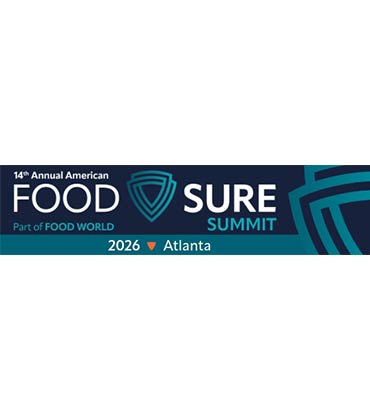THANK YOU FOR SUBSCRIBING
By Enrique Leon, AI Enterprise Architect, American Sugar Refining Inc
The Psychology of AI Credibility
By Christopher Smith, Corporate Sanitation Manager, Michael Foods
Delivering Safe foods through Effective Sanitation
By Michael Coley, Food Safety & Quality Manager, Symrise AG
Leading Food Safety Through Standards And Strategy

Mitigating Risk by Simplifying Food Safety Reports
Sharon Maloney, Food Safety and Quality Manager, Portillo’s Hot Dogs, LLC

 Sharon Maloney, Food Safety and Quality Manager, Portillo’s Hot Dogs, LLC
Sharon Maloney, Food Safety and Quality Manager, Portillo’s Hot Dogs, LLCStarting in 1987, I have held multiple roles at Portillo’s. I’ve seen the brand grow from a Chicagoland company with ten restaurants and 400 team members to a 10-state operation with 8,000 team members. As the Food Safety Manager, I am responsible for the food safety programs for our restaurants. The journey has been exhilarating, but it hasn’t come without its challenges. With an increase in food safety inspections from regulatory agencies, internal reviews, and vendor reports, our managers were drowning in paperwork, confining them to their desks. We needed to revolutionize our food safety reporting process, simplifying it without compromising on vital details.
Identifying Key Performance Indicators (KPIs) for Food Safety
After a thorough evaluation of KPIs, Portillo’s opted for a two-tier system to funnel seven different reports into a single source of information. The first tier consists of reports that focus solely on food safety performance, encompassing health inspections, audits, and meticulous tracking of food and equipment temperatures. Tier two contains reports pertaining to standard business practices, including pest control reports, repair requests, and valuable guest comments.
Setting the Bar for Food Safety Standards
To maintain Portillo’s legacy as an unrivaled leader, we hold ourselves to standards that go above and beyond regulatory requirements wherever possible. Portillo’s has set ambitious standards across all its KPIs, resulting in clarity and focus for every aspect of food safety tracking.
Creating the Scorecard
Portillo’s finance department handles copious amounts of data, so I collaborated with the financial planning and analysis (FP&A) team on the best solution. Their recommendation to utilize a tool we already had -- Microsoft Excel -- was a game-changing solution. Implementing a scorecard powered by Excel wouldn’t burden anyone’s budget.
Our teams were already well-versed in the program, and it facilitated seamless online sharing. A triple win!
The first version of the scorecard contained all the numerical values from the separate reporting groups. The numbers were clearly organized and legible, but a manager would still need to evaluate what the numbers meant operationally. The report was frustrating to read due to all that was included. It was time to iterate on what we’d build to produce a more effective report style.
 Leveraging conditional formatting within Excel was the solution. This automated the process to generate a color-coded heat map that provided colors that indicated the level of compliance at each restaurant. If the restaurant met or exceeded a standard, the corresponding cell would be marked with a “1” and turn green. If corrective action was required based on a report, a “2” would be marked, and the cell would turn red.
Leveraging conditional formatting within Excel was the solution. This automated the process to generate a color-coded heat map that provided colors that indicated the level of compliance at each restaurant. If the restaurant met or exceeded a standard, the corresponding cell would be marked with a “1” and turn green. If corrective action was required based on a report, a “2” would be marked, and the cell would turn red.
A Must: Testing
Regardless of how impressive a program appears on paper; field testing is an indispensable prerequisite before a full-scale launch. Failure to do so risks undermining the faith and respect of your staff, should the program falter, or if the training material is not comprehensive yet still digestible during the release.
"The not-so-secret ingredients to a successful program are simplification, continuous improvement, and the pursuit of excellence in our shared goal of safeguarding public health"
My favorite moment from this project occurred during the first meeting with the test group. I explained the scorecard would provide a single source for monitoring food safety. Then I presented the original numerical worksheet. SILENCE! It was the response I anticipated. Then I displayed the heat map version they would be testing. The team immediately understood compliance levels. SUCCESS! The reveal created the biggest switch from a negative to a positive response I have ever experienced during a meeting.
Testing Timeline
For testing, I selected one market – a small group -- to evaluate the scorecard’s performance for six months. Although it may seem like an extended duration, the feedback we received proved to be invaluable.
The initial four weeks were dedicated to training, then the subsequent eight weeks were focused on gathering feedback for all sections of the scorecard and ensuring the accuracy of the automated data. Based on the feedback received, subtle adjustments were made, and testing continued for an additional three months.
Unveiling the Scorecard
The launch of the Food Safety Scorecard was an undeniable success. We conducted thorough training for our regional leaders and assisted them with cascading the information down to the restaurants. We also posted job aids for added support.
Considering a Food Safety Scorecard for Your Team?
 1. Clearly define the food safety areas you wish to measure, ensuring that the selected KPIs provide measurable results.
1. Clearly define the food safety areas you wish to measure, ensuring that the selected KPIs provide measurable results.
2. Consider who will review the reports and who will be accountable for corrective actions.
3. Test your scorecard on a small group before launching companywide. Releasing a flawed program hinders its success.
4. Conduct an introductory session to prepare your teams for the official launch. Provide post-training job aids that capture essential points and address frequently asked questions.
5. Evaluate your scorecard program at least every six months and make necessary adjustments. Evaluate if the data you are collecting is necessary to determine your food safety performance.
Navigating the intricate terrain of our fast-paced and tightly regulated industry can undoubtedly seem overwhelming. Yet, these objectives are within reach for any organization. Just remember that the not-so-secret ingredients to a successful program are simplification, continuous improvement, and the pursuit of excellence in our shared goal of safeguarding public health.
Read Also















